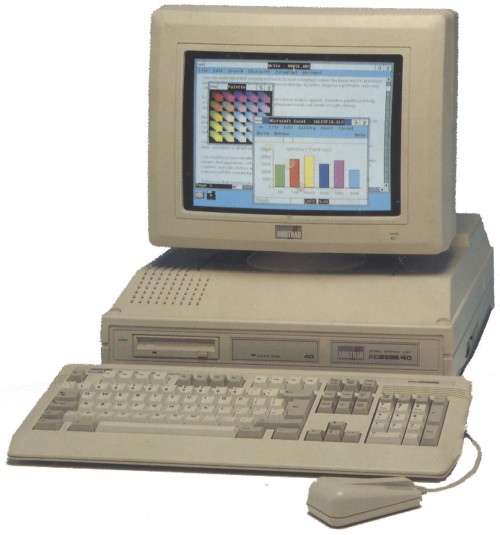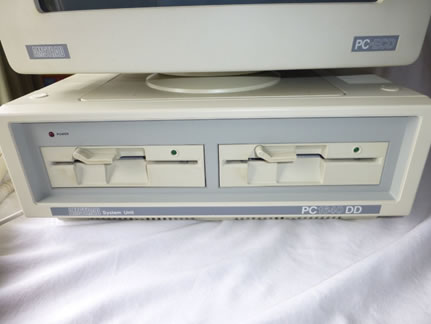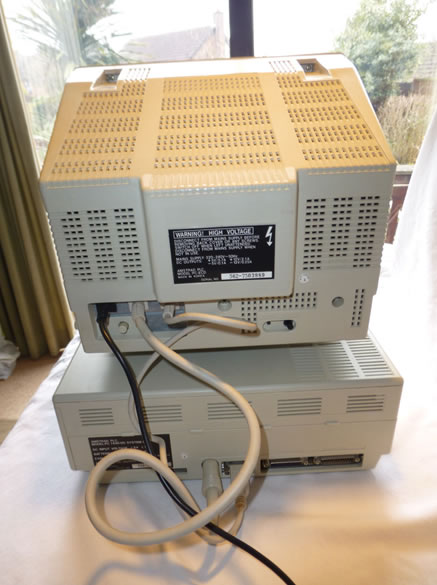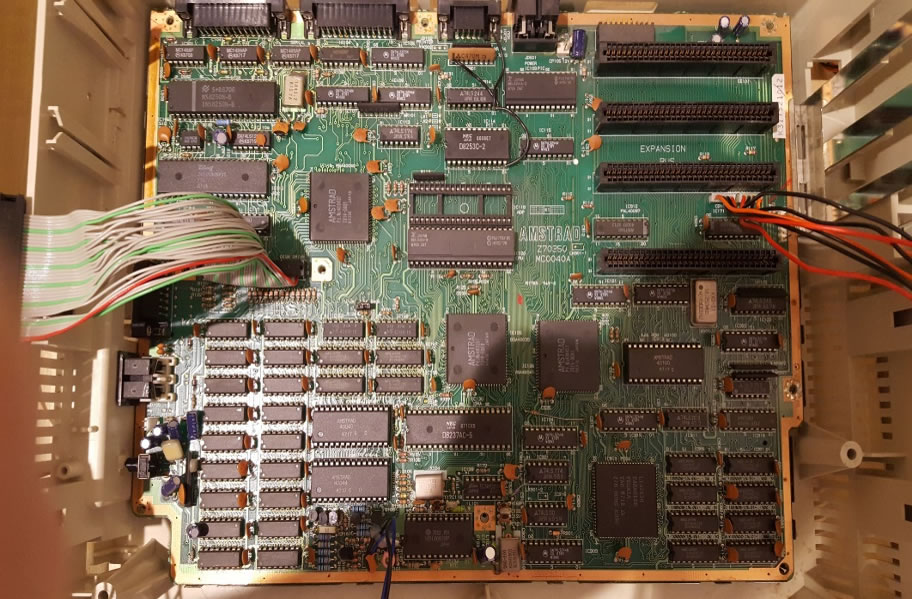My Amstrad PC Stuff
Going back to my school days (Skool Daze?), and specifically in 1989-1990, our secondary school had about 12 Amstrad PCs and a really old computer called an Apollo - that's all we had in the whole school, but this was normal for the very late 1980s. The Amstrads were a mix of PC1512s and PC1640s, some with the monochrome monitor (PC1512 MM output CGA but in greyscales, PC1640 MD output Hercules mono) and others with colour CGA or colour EGA. The arrangement allowed for two students to one PC in our GCSE Computer Studies class, so my best friend and I, being computer geeks, always made a beeline for the top-of-the-range PC1640 with the "Extended Colour Display" (EGA).
We would usually be asked to run a program called "BBC Basic" which was a DOS-based BASIC interpreter that was supposedly a modern day ancestor to the Acorn BBC BASIC interpreter of 1983.
Since then I have wanted to get my hands on a working PC1640 with ECD display. Over the years, auctions have cropped up to allow me to get a good deal on some Amstrad parts, but as of yet I have still to get a fully working PC1640. I have a tendency to seek bargains, so whilst a lot of Amstrad PCs have come across my monitor, they have either been 'For collection only' (and too far away to reasonably go for) or they are priced too high for what I am prepared to pay, This page catalogues the bits I have acquired over the years, and what I am still looking for.
PC1640 Motherboard
Around December 2017 I picked up a PC1640 motherboard for £19 including delivery. Advertised as 'used', I had no means of testing this, so it was perhaps a bit risky but the low price was too good to pass up. The reason this cannot be easily tested is because these Amstrads have their power supply in the monitor, and use a proprietary DIN connector to send power to the system unit. The newest chip on the board indicates that this was manufactured around week 40 of 1988 - fairly late on in the PC1640s relatively short life, as that same year Amstrad launched its successors: the PC2086, PC2286 and PC2386 machines.
This motherboard has part #Z70352 MC0042D. When I was finally able to test it, it came up with "Amstrad PC 640K (V3.1) (c)1988 Amstrad plc".
Boxed PC1640 with ECD Monitor
Shortly after, in April 2018, I managed to get a whole PC1640 with ECD monitor. This was the PC1640-DD (dual drive) variant, so no hard disk (at least not from the factory). Was this the golden ticket I had been waiting for? Sadly no - it was advertised as 'for parts or not working'. Nothing appeared on the screen according to the seller. I won the auction anyway for £47 + £20 P&P. The computer came in its original boxes, complete with keyboard, mouse, manuals and floppy disks.
 |
A very tidy-looking PC1640DD with PC-ECD monitor
Sure enough, upon testing I was unable to get any life out of the monitor but the built-in PSU was powering the system unit just fine. It went through the POST sequence, attempted to boot from one floppy drive, then the other, and the keyboard's Caps Lock and Num Lock key LEDs lit up when pressed.
To test this further, I installed my trusty Cirrus Logic CL-GD510 SVGA card and disabled the onboard Paradise PEGA-1A graphics chip by setting DIP switch 10 to ON (down). These switches are conveniently located at the rear of the system unit, accessible without having to open up the computer. I then connected the SVGA card up to a known-working LCD monitor, and as expected, the computer works!
Looking at the motherboard the newest chip appears to be from week 18, 1987 which is 27th April. That makes this computer one of the first PC1640s that were built! Amstrad started shipping the PC1640 2 months after this date!
The motherboard has part #Z70350 MC0040A. On boot-up, it displays "Amstrad PC 640K (V3) (c)1987 Amstrad plc".
Amstrad 5x86 Keyboard
In April 2019 I was looking for a switchable XT/AT keyboard. This is one that has a switch to allow the keyboard to work in either PC/XT mode or AT mode. Numerous manufacturers produced these dual-function keyboards as it was no doubt cheaper to design and manufacture a single keyboard for their entire range of PC clones than to create two different keyboards.
I was looking for a cheap XT keyboard to go with my original XT-compatible PC. It turns out PC/XT keyboards are now rather rare, and those with an XT/AT switch even more so!
This Amstrad one came up - with nothing more than "Amstrad keyboard model KB-5" as a description, and bundled with a set of original Amstrad 5.25" floppy disks. The all-in price was £22. Knowing Amstrad's propensity for making things non-standard, I did some research before bidding. It turns out the KB-5 was designed to work with the 5th generation of Amstrad PCs - that is, the PC5086, PC5286 and PC5386 SX. My research concluded that these were the first Amstrad PCs to use the IBM standard keyboard connector, both mechanically and electrically.
Once it arrived I initially tested it on one of my retro AT computers, and it worked perfectly. I then flicked the switch and tested it on my original XT clone, and again it worked great, so this is a win - I now have a multi-mode PC keyboard!
Still Looking For...
Of course the key piece that I am still looking for is a working ECD monitor. I have opened up the one I have in case of any obvious signs that might tell me why it's not working, but nothing was obvious, and since I am not confident working with very high-voltage, high-current appliances like CRTs I put it back together and it went back into storage.
If you have a working ECD that you are prepared to donate or sell to me, do get in touch!
Another item that would be the icing on the cake is an original 'Hardcard' - these were RLL hard disks mounted side-on beside a hard disk controller card on a metal frame that slotted into one of the free expansion slots. A clever design since it still allowed for two floppy drives at the front of the machine! Many of these had hard disks made by Miniscribe, though some were Western Digital.

A typical "hard card" from the late 1980s
Capacities were 20 MB, 30 MB or 40 MB. For an XT class computer, any hard disk was considered pretty luxurious!
Another item I would love to get is an Amstrad PC2286. My Mum and Dad got one of these as their very first home PC back in around 1990. It was bought at auction from British Computer Auctions, and came with a small MFM or RLL 40 MB hard drive and colour VGA graphics. Its primary use was for word processing and spreadsheet using WordPerfect 5.1 and Borland Quattro Pro. In the evenings it would also be used to play Railroad Tycoon, Civilization, and Hoyles Book of Card Games.

The PC2286-40, launched in 1989, ran at 12.5 MHz
These second-series of Amstrad PCs were the first to come with a 3.5" floppy disk drive instead of the older 5.25" type. The only upgrade we did to this machine was install an Ad Lib-compatible sound card - an Orchid Sound Producer.


